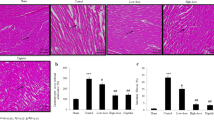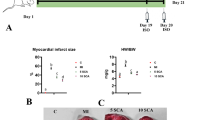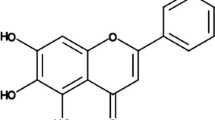Abstract
Scopoletin is a phenolic coumarin isolated from a variety of plants and was originally used to treat various diseases including arthritis as well as bone-related diseases. The goal of this study was to determine scopoletin’s therapeutic potential in an animal model of myocardial infarction induced with ISO. There were five groups of albino male rats. Group I (control) animals were orally treated with olive oil. Group II (scopoletin) animals were pre-treated orally with a 50-mg dosage of scopoletin for 28 days. Group III (ISO-treated) animals were treated with 85 mg/kg of ISO subcutaneously for 2 consecutive days (29th and 30th day). Group IV (scopoletin and ISO) animals were pre-treated orally with 25 mg of scopoletin for 28 days before exposure to ISO. Group V (scopoletin and ISO) animals were pre-treated with 50 mg of scopoletin for 28 days before exposure to ISO. In the ISO-administered animals, a wider heart-to-body weight ratio, a higher heart weight, higher cardiac diagnostic markers, higher MDA levels and related antioxidant levels, inflammatory, and apoptotic markers were observed. Scopoletin pre-treatment with ISO (25 and 50 mg/kg b.wt) significantly reduced heart-to-body weight ratio, cardiac diagnostic markers, MDA, inflammatory markers, and apoptotic markers. Meantime, a pre-treatment with scopoletin increased the levels of antioxidant enzymes. Inflammation and necrosis were observed in the histopathology of heart tissue of ISO-treated animals and these histopathological conditions were reversed by scopoletin pretreatment. The antioxidant and anti-inflammatory properties of ISO-treated rats were shown to be increased by scopoletin, showing its therapeutic potential against cardiovascular diseases. Through the use of its antioxidant and anti-inflammatory properties, scopoletin exhibited anti-myocardial infarction properties. However, further preclinical studies will be required to demonstrate the mechanism of action of scopoletin involved in anti-myocardial infarction.






Similar content being viewed by others
Data Availability
Not applicable.
References
Lu, L., Liu, M., Sun, R., Zheng, Y., & Zhang, P. (2015). Myocardial infarction: symptoms and treatments. Cell Biochemistry and Biophysics, 72(3), 865–867.
Saleh, M., …, Ambrose, J. A. (2018). Understanding myocardial infarction [version 1; peer review: 2 approved]. F1000Research, 27(F1000 Faculty Rev), 1378.
Graham, I., Atar, D., Borch-Johnsen, K., Boysen, G., Burell, G., Cifkova, R., Dallongeville, J., De Backer, G., Ebrahim, S., Gjelsvik, B., & Herrmann-Lingen, C. (2007). European guidelines on cardiovascular disease prevention in clinical practice: Executive summary: Fourth Joint Task Force of the European Society of Cardiology and Other Societies on Cardiovascular Disease Prevention in Clinical Practice (Constituted by representatives of nine societies and by invited experts). European Heart Journal, 28(19), 2375–414.
Jayara, J. C., Davatyan, K., Subramanian, S. S., & Priya, J. (2019). Epidemiology of myocardial infarction. Myocardial Infarction, 3, 10.
Singh, R. B., Pella, D., Neki, N. S., Chandel, J. P., Rastogi, S., Mori, H., Otsuka, K., & Gupta, P. (2004). Mechanisms of acute myocardial infarction study (MAMIS). Biomedicine & Pharmacotherapy, 58, S111–S115.
Sharma, M., Kishore, K., Gupta, S. K., Joshi, S., & Arya, D. S. (2001). Cardioprotective potential of Ocimum sanctum in isoproterenol induced myocardial infarction in rats. Molecular and Cellular Biochemistry, 225(1), 75–83.
Turer, A. T., & Hill, J. A. (2010). Pathogenesis of myocardial ischemia-reperfusion injury and rationale for therapy. The American Journal of Cardiology, 106(3), 360–368.
Afroz, R., Tanvir, E. M., Karim, N., Hossain, M. S., Alam, N., Gan, S. H., & Khalil, M. I. (2016). Sundarban honey confers protection against isoproterenol-induced myocardial infarction in wistar rats. BioMed Research International, 2016, 6437641. https://doi.org/10.1155/2016/6437641
Neri, M., Fineschi, V., Di Paolo, M., Pomara, C., Riezzo, I., Turillazzi, E., & Cerretani, D. (2015). Cardiac oxidative stress and inflammatory cytokines response after myocardial infarction. Current Vascular Pharmacology, 13(1), 26–36.
Abhilash, P. A., Nisha, P., Prathapan, A., Nampoothiri, S. V., Cherian, O. L., Sunitha, T. K., & Raghu, K. G. (2011). Cardioprotective effects of aqueous extract of Oxalis corniculata in experimental myocardial infarction. Experimental and Toxicologic Pathology, 63(6), 535–540.
Hazini, A., Cemek, M., Alpdağtaş, S., Önül, A., Şenel, Ü, Kocaman, T., Dur, A., Iraz, M., & Uyarel, H. (2015). Investigation of ischemia modified albumin, oxidant and antioxidant markers in acute myocardial infarction. Postępy w KardiologiiInterwencyjnej = Advances in Interventional Cardiology, 11(4), 298.
Jiang, T., Zhang, L., Ding, M., & Li, M. (2019). Protective effect of vaccine against myocardial infarction in rats via modulation of oxidative stress, inflammation, and the PI3K/Akt pathway. Drug Design Development and Therapy, 13, 3773.
de Britto, R. M., da Silva-Neto, J. A., Mesquita, T. R., de Vasconcelos, C. M., de Almeida, G. K., de Jesus, I. C., Santos, D., Souza, P. H., Miguel-dos-Santos, D. S., de Sá, R., & Dos Santos, L. A. (2018). F. S. Myrtenol protects against myocardial ischemia-reperfusion injury through antioxidant and anti-apoptotic dependent mechanisms. Food and Chemical Toxicology, 111, 557–66.
Boarescu, P. M., Boarescu, I., Bocșan, I. C., Pop, R. M., Gheban, D., Bulboacă, A. E., Nicula, C., Râjnoveanu, R. M., & Bolboacă, S. D. (2019). Curcumin nanoparticles protect against isoproterenol induced myocardial infarction by alleviating myocardial tissue oxidative stress, electrocardiogram, and biological changes. Molecules, 24(15), 2802.
Yu, Y., Jin, L., Zhuang, Y., Hu, Y., Cang, J., & Guo, K. (2018). Cardioprotective effect of rosuvastatin against isoproterenol-induced myocardial infarction injury in rats. International Journal of Molecular Medicine, 41(6), 3509–3516.
Gnonlonfin, G. B., Sanni, A., & Brimer, L. (2012). Review scopoletin–a coumarinphytoalexin with medicinal properties. Critical Reviews in Plant Sciences, 31(1), 47–56.
Ding, Z., Dai, Y., Hao, H., Pan, R., Yao, X., & Wang, Z. (2008). Anti-inflammatory effects of scopoletin and underlying mechanisms. Pharmaceutical Biology, 46(12), 854–860.
Armenia, A., Hidayat, R., Meiliani, M., & Yuliandra, Y. (2019). Blood pressure lowering effect of scopoletin on oxidative stress-associated hypertensive rats. Journal of Research in Pharmacy, 23(2), 249-258.
Sundaram, C. S., Rao, U. M., & Simbak, N. (2015). Regulatory efficacy of scopoletin, a biocoumarin on aortic oxidolipidemic stress through antioxidant potency as well as suppression of mRNA expression of inos gene in hypercholesterolemic rats. Der Pharmacia Lettre, 7, 57–67.
Sarkar, T., Salauddin, M., & Chakraborty, R. (2020). In-depth pharmacological and nutritional properties of bael (Aegle marmelos): A critical review. Journal of Agriculture and Food Research, 2, 100081. ISSN 2666 – 1543. https://doi.org/10.1016/j.jafr.2020.100081
Sarkar, T., Salauddin, M., Roy, A., Sharma, N., Sharma, A., Yadav, S., Jha, V., Rebezov, M., Khayrullin, M., Thiruvengadam, M., Chung, I. M., Shariati, M. A., & Simal-Gandara, J. (2022). Minor tropical fruits as a potential source of bioactive and functional foods. Critical Reviews in Food Science and Nutrition. https://doi.org/10.1080/10408398.2022.2033953
Allawadhi, P., Khurana, A., Sayed, N., Kumari, P., & Godugu, C. (2018). Isoproterenol-induced cardiac ischemia and fibrosis: Plant‐based approaches for intervention. Phytotherapy Research, 32(10), 1908–1932.
Govindasami, S., Uddandrao, V. V., Raveendran, N., & Sasikumar, V. (2020). Therapeutic potential of biochanin-A against isoproterenol-induced myocardial infarction in rats. Cardiovascular & Hematological Agents in Medicinal Chemistry (Formerly Current Medicinal Chemistry-Cardiovascular & Hematological Agents, 18(1), 31–6.
Yang, Y., Ding, Z., Zhong, R., Xia, T., Wang, W., Zhao, H., Wang, Y., & Shu, Z. (2020). Cardioprotective effects of a FructusAurantii polysaccharide in isoproterenol-induced myocardial ischemic rats. International Journal of Biological Macromolecules, 155, 995–1002.
Gianazza, E., Brioschi, M., Fernandez, A. M., & Banfi, C. (2019). Lipoxidation in cardiovascular diseases. Redox Biology, 23, 101119.
Madole, M. B., Bachewar, N. P., & Aiyar, C. M. (2015). Study of oxidants and antioxidants in patients of acute myocardial infarction. Advanced Biomedical Research, 4, 241. https://doi.org/10.4103/2277-9175.168608
Pérez-Torres, I., Torres-Narváez, J. C., Guarner-Lans, V., Díaz-Díaz, E., Perezpeña-Diazconti, M., Palacios, A. R., & Manzano-Pech, L. (2019). Myocardial protection from ischemia-reperfusion damage by the antioxidant effect of Hibiscus sabdariffa Linnaeus on metabolic syndrome rats. Oxidative Medicine and Cellular Longevity, 2019, 1724194. https://doi.org/10.1155/2019/1724194
Sun, L., Hu, Y., Mishra, A., Sreeharsha, N., Moktan, J. B., Kumar, P., & Wang, L. (2020). Protective role of poly (lactic-co‐glycolic) acid nanoparticle loaded with resveratrol against isoproterenol‐induced myocardial infarction. Biofactors (Oxford, England), 46(3), 421–431.
Shahzad, S., Hasan, A., Faizy, A. F., Mateen, S., Fatima, N., & Moin, S. (2018). Elevated DNA damage, oxidative stress, and impaired response defense system inflicted in patients with myocardial infarction. Clinical and Applied Thrombosis/hemostasis, 24(5), 780–789.
Cheng, L., Jin, Z., Zhao, R., Ren, K., Deng, C., & Yu, S. (2015). Resveratrol attenuates inflammation and oxidative stress induced by myocardial ischemia-reperfusion injury: role of Nrf2/ARE pathway. International Journal of Clinical and Experimental Medicine, 28(7), 10420.
Goyal, S. N., Sharma, C., Mahajan, U. B., Patil, C. R., Agrawal, Y. O., Kumari, S., Arya, D. S., & Ojha, S. (2015). Protective effects of cardamom in isoproterenol-induced myocardial infarction in rats. International Journal of Molecular Sciences, 16(11), 27457–27469.
Lagunas-Herrera, H., Tortoriello, J., Herrera-Ruiz, M., Martínez-Henández, G. B., Zamilpa, A., Santamaría, L. A., Lorenzana, M. G., Lombardo-Earl, G., & Jiménez-Ferrer, E. (2019). Acute and chronic antihypertensive effect of fractions, tiliroside and scopoletin from Malvaparviflora. Biological and Pharmaceutical Bulletin, 42(1), 18–25.
Singh, P. K., Gari, M., Choudhury, S., Shukla, A., Gangwar, N., & Garg, S. K. (2020). Oleic acid prevents isoprenaline-induced cardiac injury: effects on cellular oxidative stress, inflammation and histopathological alterations. Cardiovascular Toxicology, 20(1), 28–48.
Jacob, R., & Khan, M. (2018). Cardiac biomarkers: what is and what can be. Indian Journal of Cardiovascular Disease in Women-WINCARS, 3(04), 240–244.
Carvalho, G., & Rassi, S. (2016). The prognostic value of CK-MB in acute myocardial infarction in developing countries: A descriptive study. Angiol, 4, 183. https://doi.org/10.4172/2329-9495.1000183
Cao, Z., Zhao, M., Xu, C., Zhang, T., Jia, Y., Wang, T., & Zhu, B. (2019). Diagnostic roles of postmortemcTn I and cTn T in cardiac death with special regard to myocardial infarction: a systematic literature review and meta-analysis. International journal of molecular sciences, 20(13), 3351.
Parlakpinar, H., Orum, M. H., & Ozhan, O. (2017). Myocardial necrosis markers in myocardial ischemia reperfusion (MI/R) injury: A review. Medicine Science, 6(1), 163–171. https://doi.org/10.5455/medscience.2016.05.8520
Hou, M., Lu, L., Wu, X., & Liu, H. (2022). LCZ696 ameliorates isoproterenol-induced acute heart failure in rats by activating the Nrf2 signaling pathway. Applied Bionics and Biomechanics, 2022, 6077429. https://doi.org/10.1155/2022/6077429
Zhou, J., Duan, X., Wang, J., Feng, Y., & Yuan, J. (2022). Valsartan regulates PI3K/AKT pathways through lncRNA GASL1 to improve isoproterenol-induced heart failure. Disease Markers, 2022, 1447399. https://doi.org/10.1155/2022/1447399
Wang, F., Zhang, H., Lv, G., Liu, Z., Zheng, X., & Wu, X. (2020). Fucoxanthin averts isoprenaline hydrochloride-induced myocardial infarction in rats. Pharmacognosy Magazine, 16(69), 214.
George, M. J., Kleveland, O., Garcia-Hernandez, J., Palmen, J., Lovering, R., Wiseth, R., Aukrust, P., Engmann, J., Damås, J. K., Hingorani, A. D., & Gullestad, L. (2020). Novel Insights Into the Effects of Interleukin 6 Antagonism in Non–ST‐Segment–Elevation Myocardial Infarction Employing the SOMA scan Proteomics Platform. Journal of the American Heart Association, 9(12), e015628.
Mahmoud, A. H., Taha, N. M., Zakhary, M., & Tadros, M. S. (2019). PTEN gene & TNF-alpha in acute myocardial infarction. IJC Heart & Vasculature, 23, 100366.
Buckley, L. F., & Abbate, A. (2018). Interleukin-1 blockade in cardiovascular diseases: a clinical update. European Heart Journal, 39(22), 2063–2069.
Sajid, A., Ahmad, T., Ikram, M., Khan, T., Shah, A. J., Mahnashi, M. H., Alhasaniah, A. H., Al Awadh, A. A., Almazni, I. A., & Alshahrani, M. M. (2022). Cardioprotective potential of aqueous extract of Fumaria indica on isoproterenol-induced myocardial infarction in SD rats. Oxidative Medicine and Cellular Longevity, 2022, 2112956. https://doi.org/10.1155/2022/2112956
Nguelefack-Mbuyo, E. P., Nokam, F., Tchinda, N. L., Goumtsa, A. F., Tsabang, N., & Nguelefack, T. B. (2022). Vasorelaxant and antioxidant effects of Aframomum pruinosum Gagnep. (Zingiberaceae) Seed extracts may mediate their cardioprotective activity against isoproterenol-induced myocardial infarction. Evidence-Based Complementary and Alternative Medicine, 2022, 7257448. https://doi.org/10.1155/2022/7257448
Teringova, E., & Tousek, P. (2017). Apoptosis in ischemic heart disease. Journal of Translational Medicine, 15(1), 1–7.
Islam, D., Banerjee Shanta, M., Akhter, S., Lyzu, C., Hakim, M., Islam, M., Mohanta, L. C., Lipy, E. P., & Roy, D. C. (2020). Cardioprotective effect of garlic extract in isoproterenol-induced myocardial infarction in a rat model: assessment of pro-apoptotic caspase-3 gene expression. Clinical Phytoscience, 6(1), 1–9.
Avrutsky, M. I., & Troy, C. M. (2021). Caspase-9: a multimodal therapeutic target with diverse cellular expression in human disease. Frontiers in Pharmacology, 12, 1728.
Othman, A. I., Elkomy, M. M., El-Missiry, M. A., & Dardor, M. (2017). Epigallocatechin-3-gallate prevents cardiac apoptosis by modulating the intrinsic apoptotic pathway in isoproterenol-induced myocardial infarction. European Journal of Pharmacology, 794, 27–36.
Ouyang, B., Li, Z., Ji, X., Huang, J., Zhang, H., & Jiang, C. (2019). The protective role of lutein on isoproterenol-induced cardiac failure rat model through improving cardiac morphology, antioxidant status via positively regulating Nrf2/HO-1 signalling pathway. Pharmaceutical Biology, 57(1), 529–535. https://doi.org/10.1080/13880209.2019.1649436
Author information
Authors and Affiliations
Contributions
All authors contributed equally.
Corresponding author
Ethics declarations
Ethics Approval
Not applicable.
Consent to Participate
All authors have their consent to participate.
Consent to Publish
All authors have their consent to publish their work.
Competing Interests
The authors declare no competing interests.
Additional information
Publisher’s Note
Springer Nature remains neutral with regard to jurisdictional claims in published maps and institutional affiliations.
Rights and permissions
Springer Nature or its licensor holds exclusive rights to this article under a publishing agreement with the author(s) or other rightsholder(s); author self-archiving of the accepted manuscript version of this article is solely governed by the terms of such publishing agreement and applicable law.
About this article
Cite this article
Rong, N., Yang, R., Ibrahim, I.A.A. et al. Cardioprotective Role of Scopoletin on Isoproterenol-Induced Myocardial Infarction in Rats. Appl Biochem Biotechnol 195, 919–932 (2023). https://doi.org/10.1007/s12010-022-04123-z
Accepted:
Published:
Issue Date:
DOI: https://doi.org/10.1007/s12010-022-04123-z




